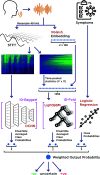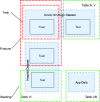Project Achoo: A Practical Model and Application for COVID-19 Detection From Recordings of Breath, Voice, and Cough
- PMID: 35582703
- PMCID: PMC9088778
- DOI: 10.1109/JSTSP.2022.3142514
Project Achoo: A Practical Model and Application for COVID-19 Detection From Recordings of Breath, Voice, and Cough
Abstract
The COVID-19 pandemic created significant interest and demand for infection detection and monitoring solutions. In this paper, we propose a machine learning method to quickly detect COVID-19 using audio recordings made on consumer devices. The approach combines signal processing and noise removal methods with an ensemble of fine-tuned deep learning networks and enables COVID detection on coughs. We have also developed and deployed a mobile application that uses a symptoms checker together with voice, breath, and cough signals to detect COVID-19 infection. The application showed robust performance on both openly sourced datasets and the noisy data collected during beta testing by the end users.
Keywords: Acoustic signal processing; Big Data applications; biomedical informatics; machine learning; public heathcare; signal detection.
Figures






Similar articles
-
QUCoughScope: An Intelligent Application to Detect COVID-19 Patients Using Cough and Breath Sounds.Diagnostics (Basel). 2022 Apr 7;12(4):920. doi: 10.3390/diagnostics12040920. Diagnostics (Basel). 2022. PMID: 35453968 Free PMC article.
-
COVID-19 detection in cough, breath and speech using deep transfer learning and bottleneck features.Comput Biol Med. 2022 Feb;141:105153. doi: 10.1016/j.compbiomed.2021.105153. Epub 2021 Dec 17. Comput Biol Med. 2022. PMID: 34954610 Free PMC article.
-
Exploring Longitudinal Cough, Breath, and Voice Data for COVID-19 Progression Prediction via Sequential Deep Learning: Model Development and Validation.J Med Internet Res. 2022 Jun 21;24(6):e37004. doi: 10.2196/37004. J Med Internet Res. 2022. PMID: 35653606 Free PMC article.
-
Automatic Recognition, Segmentation, and Sex Assignment of Nocturnal Asthmatic Coughs and Cough Epochs in Smartphone Audio Recordings: Observational Field Study.J Med Internet Res. 2020 Jul 14;22(7):e18082. doi: 10.2196/18082. J Med Internet Res. 2020. PMID: 32459641 Free PMC article.
-
Respiratory Diseases Diagnosis Using Audio Analysis and Artificial Intelligence: A Systematic Review.Sensors (Basel). 2024 Feb 10;24(4):1173. doi: 10.3390/s24041173. Sensors (Basel). 2024. PMID: 38400330 Free PMC article.
Cited by
-
Automatic detection and prediction of COVID-19 in cough audio signals using coronavirus herd immunity optimizer algorithm.Sci Rep. 2025 Jan 17;15(1):2271. doi: 10.1038/s41598-025-85140-w. Sci Rep. 2025. PMID: 39824893 Free PMC article.
-
COVID-19 Detection From Respiratory Sounds With Hierarchical Spectrogram Transformers.IEEE J Biomed Health Inform. 2024 Mar;28(3):1273-1284. doi: 10.1109/JBHI.2023.3339700. Epub 2024 Mar 6. IEEE J Biomed Health Inform. 2024. PMID: 38051612 Free PMC article.
-
A comprehensive survey on the biomedical signal processing methods for the detection of COVID-19.Ann Med Surg (Lond). 2022 Apr;76:103519. doi: 10.1016/j.amsu.2022.103519. Epub 2022 Apr 1. Ann Med Surg (Lond). 2022. PMID: 35401978 Free PMC article. Review.
-
Gradient Boosting Machine and Efficient Combination of Features for Speech-Based Detection of COVID-19.IEEE J Biomed Health Inform. 2022 Nov;26(11):5364-5371. doi: 10.1109/JBHI.2022.3197910. Epub 2022 Nov 10. IEEE J Biomed Health Inform. 2022. PMID: 35947565 Free PMC article.
-
Optimized DEC: An effective cough detection framework using optimal weighted Features-aided deep Ensemble classifier for COVID-19.Biomed Signal Process Control. 2023 May 15:105026. doi: 10.1016/j.bspc.2023.105026. Online ahead of print. Biomed Signal Process Control. 2023. PMID: 37361196 Free PMC article.
References
-
- Fu H., Fan D.-P., Chen G., and Zhou T., “COVID-19 imaging-based AI paper collection,” 2021. [Online]. Available: https://github.com/HzFu/COVID19_imaging_AI_paper_list
-
- Avetisian M. et al. , “CoRSAI: A system for robust interpretation of CT scans of COVID-19 patients using deep learning,”ACM Trans. Manage. Inf. Syst., vol. 12, no. 4, Dec. 2021, Art. no. 28, doi: 10.1145/3467471. - DOI
-
- Larremore D. B. et al. , “Test sensitivity is secondary to frequency and turnaround time for COVID-19 screening,” Sci. Adv., vol. 7, no. 1, 2021, Art. no. eabd5393. [Online]. Available: https://advances.sciencemag.org/content/7/1/eabd5393 - PMC - PubMed
LinkOut - more resources
Full Text Sources
